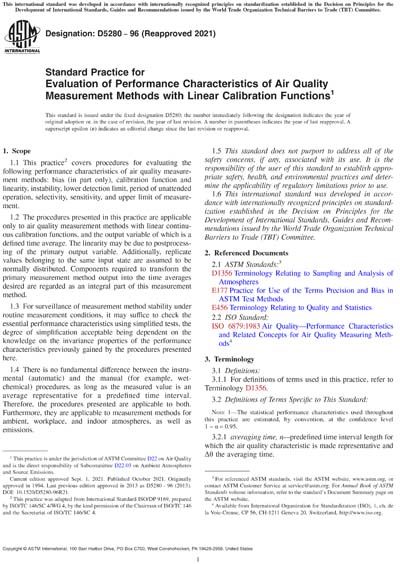Most recent
ASTM D5280-96(2021)
Standard Practice for Evaluation of Performance Characteristics of Air Quality Measurement Methods with Linear Calibration Functions
1.1This practice2 covers procedures for evaluating the following performance characteristics of air quality measurement methods: bias (in part only), calibration function and linearity, instability, lower detection limit, period of unattended operation, selectivity, sensitivity, and upper limit of measurement.
1.2The procedures presented in this practice are applicable only to air quality measurement methods with linear continuous calibration functions, and the output variable of which is a defined time average. The linearity may be due to postprocessing of the primary output variable. Additionally, replicate values belonging to the same input state are assumed to be normally distributed. Components required to transform the primary measurement method output into the time averages desired are regarded as an integral part of this measurement method.
1.3For surveillance of measurement method stability under routine measurement conditions, it may suffice to check the essential performance characteristics using simplified tests, the degree of simplification acceptable being dependent on the knowledge on the invariance properties of the performance characteristics previously gained by the procedures presented here.
1.4There is no fundamental difference between the instrumental (automatic) and the manual (for example, wet-chemical) procedures, as long as the measured value is an average representative for a predefined time interval. Therefore, the procedures presented are applicable to both. Furthermore, they are applicable to measurement methods for ambient, workplace, and indoor atmospheres, as well as emissions.
1.5This standard does not purport to address all of the safety concerns, if any, associated with its use. It is the responsibility of the user of this standard to establish appropriate safety, health, and environmental practices and determine the applicability of regulatory limitations prior to use.
1.6This international standard was developed in accordance with internationally recognized principles on standardization established in the Decision on Principles for the Development of International Standards, Guides and Recommendations issued by the World Trade Organization Technical Barriers to Trade (TBT) Committee.
Content Provider
ASTM International [astm]






